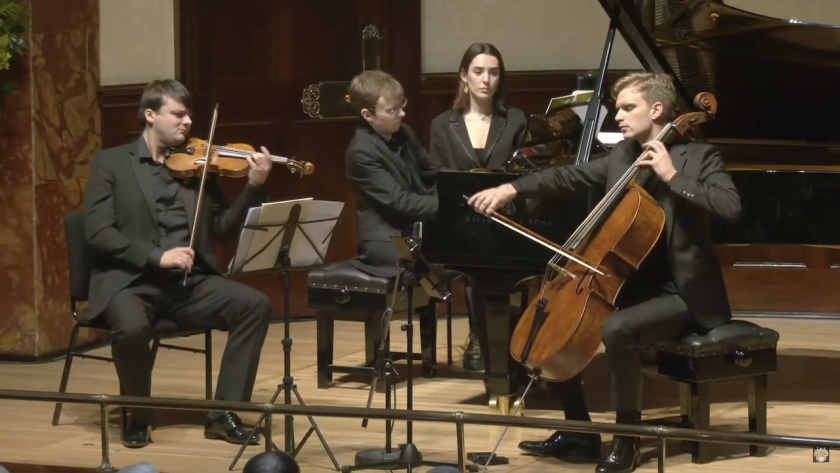The adrenalin was in full flow yesterday lunchtime at the Wigmore Hall as the dynamic young Mithras Trio delivered a vigorous, toned performance featuring Beethoven, Bridge and an electrifying new work by Joy Lisney. The trio, who have been together for just over five years, are part of Radio 3’s New Generation Artists scheme and dispatched the repertoire with an intensity and expressive range that was often as beguiling as it was exhilarating.
Frank Bridge’s Phantasie Piano Trio in C minor provided a tempestuous start to the concert, with a double forte opening that made it feel as if it began where most pieces climax. From the violin and cello’s synchronised attack on the very first semi quavers, there was a sense of the degree to which the players’ tight discipline contributed to their energy – and the rigour persisted even as the piece became more flowing and lyrical.
The Phantasie is in Bridge’s late Romantic style – distinct from his later, more dissonant works – and was composed as an entry to a competition set up by Walter Willson Cobbett, who, the programme informs us, was founder of Scandinavian Belting Ltd. Yet Cobbett’s love of industry came a distant second to his passion for chamber music, and he challenged composers to create “phantasies” as a response to Elizabethan viol “fancies”, in which variations on a theme were bound by a single over-arching structure.
Bridge, like many of his contemporaries – Britten was a pupil – was strongly influenced by nature, and in the opening section, Allegro moderato ma con fuoco, there’s a real sense of an elemental energy, as if we were next to a turbulent sea. In the dialogue between violinist Ionel Manciu and cellist Leo Popplewell especially we got a sense of the furious exchange of emotions, heightened by swirling undercurrents from Dominic Degavino on the piano.As the piece moved into the Andante con molto espressione section, a more pensive tone prevailed; we were not so much at sea as watching daylight filter into a room filled with cobwebs. Haunting and elegiac, it foreshadowed the more famous Beethoven “Ghost” Piano Trio to come, not least in Manciu’s ravishing, ethereal solos.
Then we were whipped up in the Allegro scherzoso, in which the discipline of the group came to the fore once more in a series of highly articulated runs and arpeggiated sequences. In the reprisal of the theme in the Allegro moderato we again experienced the violin and cello in a tempestuous dance before the escalating ecstatic finale.From Bridge, we were hurtled into the 21st century with Joy Lisney’s riveting, atmospheric Petrichor. The title, as she herself explains, comes from the Ancient Greek for “petra” – rock - and “ichor” – the liquid that flows in the veins of immortals. Today we use it more prosaically to describe the scent that comes off the earth when rain falls after a dry spell.
In the opening Lento moderato movement there was a real sense of surface tension in the high descending notes on both the violin and cello. Then the music became more expansive, with angular descending sequences on the piano and responding trills and deeper notes from the violin and cello, giving a sense of the earth shivering into life in response to the water.
The composition was a strong platform for all three performers to display a wide range of techniques, which they executed to perfection. This amplified the sense of the piece’s taut intelligence throughout, whether through rattling rasping bow textures in the Scherzo Allegretto, the sense of unease ushered in through sly glissandi or the contrast between the hardness of the earth and the shimmering water reflected in the piano part.
Beethoven’s Piano Trio in D, Op. 70 (No. 1) “Ghost” provided the resonant finale. As with the Bridge, they executed the opening movement with a thrilling dash and vigour, heightened by the sense of vivacious dialogue between the instruments. In certain passages, the luminosity of Degavino’s piano playing made you hope that there will be a day when we can hear his Emperor Piano Concerto.
In the famous "ghost" movement, Largo assai ed espressivo, there was the one weakness of the concert – though the technique and dynamic range was flawless, it felt that the overall tone wasn’t quite edgy, quite ghostly enough. That minor cavil aside, the build in tension at the end was stunningly beautiful and in their shimmering, iridescent Presto this exciting young trio provided a triumphant finale.














Add comment